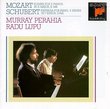| All Artists: Gustav Mahler, Andrew Litton, Dallas Symphony Orchestra, Dallas Symphony Chorus, Nathalie Stutzman, Texas Boys Choir Title: Mahler: Symphony No. 3 Members Wishing: 0 Total Copies: 0 Label: Delos Records Original Release Date: 2/29/2000 Release Date: 2/29/2000 Genres: Special Interest, Classical Style: Symphonies Number of Discs: 2 SwapaCD Credits: 2 UPC: 013491324821 |
Search - Gustav Mahler, Andrew Litton, Dallas Symphony Orchestra :: Mahler: Symphony No. 3
 | Gustav Mahler, Andrew Litton, Dallas Symphony Orchestra Mahler: Symphony No. 3 Genres: Special Interest, Classical
Mahler's longest and most kaleidoscopic symphony has been getting more attention in recent years both on concert schedules and on disc--from the dull, uninspired account by López-Cobos to Esa-Pekka Salonen's brilliant... more » |
Larger Image |
CD DetailsSynopsis
Amazon.com Mahler's longest and most kaleidoscopic symphony has been getting more attention in recent years both on concert schedules and on disc--from the dull, uninspired account by López-Cobos to Esa-Pekka Salonen's brilliant interpretation. It's a tall order to pull off, whether in the tremendously vivid details of Mahler's score or the overall pantheistic vision that holds its colossal structure together. Andrew Litton has so far proved himself a solid Mahler conductor, with a respectable Second Symphony in his quiver, the previous installment of a continuing cycle. But this live Third puts him in the top rank. Litton shows a fantastic ear for those details, which actually seem to pullulate in the first movement. His approach is clear-headed, with a vertical sense of musical events that is riveting. You may not be as tempted to air conduct as in Bernstein's magnificent vision or in another gold standard, the Jascha Horenstein account--there's less of the cosmological panic and blissful revelation than what you'll find with Lenny, to be sure--but Litton's stewardship clearly signals a general shift away from the indulgences of more subjective Mahler interpretations from decades past. And the clarity that results is revealing, whether in the shimmering wonders of the posthorn music or the lovingly unfolded final paean. Delos's "Virtual Reality Recording" sound is superbly realistic, and the Dallas Symphony's excellent playing makes you wonder how the myth of the "big five" American orchestras continues. At the two-for-one price, you can't go wrong. --Thomas May Similarly Requested CDs
|
CD ReviewsA very enjoyable rendition F. Behrens | Keene, NH USA | 03/28/2000 (5 out of 5 stars) "There will always be arguments about how a Mahler symphony "should" sound. Granted that a lightweight approach to (say) the Second would be quite inappropriate, as would the Eighth with a small chorus. Suffice it to say that Von Karajan's Mahler is not Bernstein's, and neither of them should be Litton's. I want only to say that I enjoyed the Delos release of Mahler's very much indeed and do not particularly care how this and that movement or moment were handled by other composers. The sound balances seem good and Andrew Litton's Dallas Symphony Orchestra and [Women's] Chorus are in a good (how can one say "proper"?) relationship to one another. Contralto Nathalie Stutzmann is marvelous in her brief solo with the Nietzsche text and its reiterated "Tief (deep)"; and I especially like the way her voice blends with the full chorus and Texas Boys Choir. And of course the Delos sound is exemplary. So while many might prefer the rival sets, this Delos release should be given a fair hearing." A CD To Treasure George John | Houston, TX United States | 08/28/2002 (5 out of 5 stars) "I can't put properly into words how much I was impressed, amazed, and moved by this performance. I must now track down Barry Guerrero's other reviews on the Classics Today Website ...because of all the items I have seen reviewed on that site that have received 10/10 ratings (that I also own), this one truly deserves it.The performance quality was quite a surprise. I had no idea that Dallas had this caliber of musicians. Based on this recording, I would rank this orchestra as one of the best in the world. Wow!If I were do submit a benchmark of how an orchestra should be recorded for 16-bit CD playback in the home, this one would be among the few disks I own that I would provide (along with a couple from Reference Recordings). The balance is just wonderful. The sound stage is amazingly clear and gives a strong impression of being present for a live performance. One would have to turn to the best Hi-Rez (DVD-Audio, SACD) recordings to do any better in my estimation.Reactions to interpretations are highly personal and subjective, but for my money, this recording builds on all the things I like about the Horenstein, but, for lack of better words, goes even more deeply into the music. I find this interpretation almost across the board wonderful.This is a CD I will long treasure." Great Orchestral Playing and Sound is Awesome Minghui Kuang | 03/01/2005 (5 out of 5 stars) "I own 3 recordings of this symphony, this one, Boulez/VPO and Chailly/RCO. I can say that the level of orchestral playing by the Dallas Symphony equals if not exceeds the VPO and RCO. The Dallas brass sounds absolutely fabulous in the climax of the first movement. As a whole I enjoy the Boulez recording the most simply because he brings a Bach-like clarity to the dense orchestral scoring of this symphony. But Litton controls the ups and downs of this meandering work so well that it doesn't seem like it is over 90 minutes long. The recording is fabulous. The dynamic range is extremely wide and on good equipment this is a blast to listen to."
|

 Track Listings (25) - Disc #1
Track Listings (25) - Disc #1




